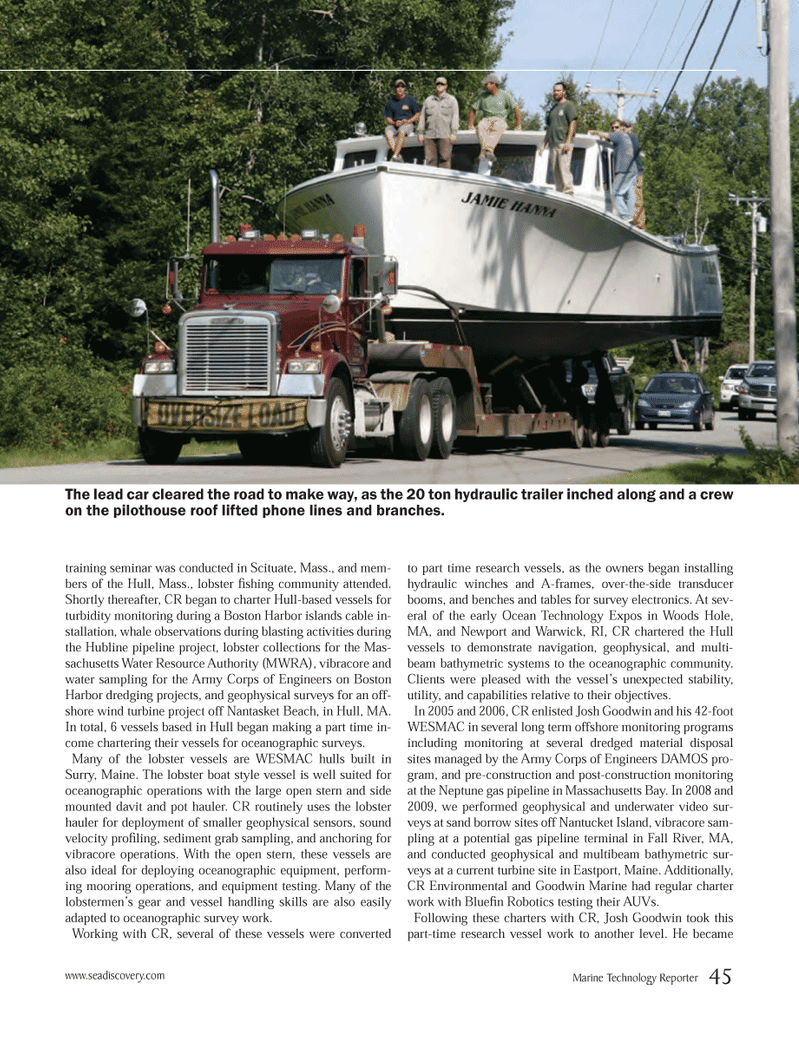
Page 45: of Marine Technology Magazine (October 2012)
Ocean Observation: Gliders, buoys & sub surface monitoring networks
Read this page in Pdf, Flash or Html5 edition of October 2012 Marine Technology Magazine
training seminar was conducted in Scituate, Mass., and mem- bers of the Hull, Mass., lobster Þ shing community attended. Shortly thereafter, CR began to charter Hull-based vessels for turbidity monitoring during a Boston Harbor islands cable in-stallation, whale observations during blasting activities during the Hubline pipeline project, lobster collections for the Mas-sachusetts Water Resource Authority (MWRA), vibracore and water sampling for the Army Corps of Engineers on Boston Harbor dredging projects, and geophysical surveys for an off- shore wind turbine project off Nantasket Beach, in Hull, MA. In total, 6 vessels based in Hull began making a part time in- come chartering their vessels for oceanographic surveys. Many of the lobster vessels are WESMAC hulls built in Surry, Maine. The lobster boat style vessel is well suited for oceanographic operations with the large open stern and side mounted davit and pot hauler. CR routinely uses the lobster hauler for deployment of smaller geophysical sensors, sound velocity proÞ ling, sediment grab sampling, and anchoring for vibracore operations. With the open stern, these vessels are also ideal for deploying oceanographic equipment, perform- ing mooring operations, and equipment testing. Many of the lobstermenÕs gear and vessel handling skills are also easily adapted to oceanographic survey work. Working with CR, several of these vessels were converted to part time research vessels, as the owners began installing hydraulic winches and A-frames, over-the-side transducer booms, and benches and tables for survey electronics. At sev- eral of the early Ocean Technology Expos in Woods Hole, MA, and Newport and Warwick, RI, CR chartered the Hull vessels to demonstrate navigation, geophysical, and multi- beam bathymetric systems to the oceanographic community. Clients were pleased with the vesselÕs unexpected stability, utility, and capabilities relative to their objectives. In 2005 and 2006, CR enlisted Josh Goodwin and his 42-foot WESMAC in several long term offshore monitoring programs including monitoring at several dredged material disposal sites managed by the Army Corps of Engineers DAMOS pro- gram, and pre-construction and post-construction monitoring at the Neptune gas pipeline in Massachusetts Bay. In 2008 and 2009, we performed geophysical and underwater video sur- veys at sand borrow sites off Nantucket Island, vibracore sam- pling at a potential gas pipeline terminal in Fall River, MA, and conducted geophysical and multibeam bathymetric sur- veys at a current turbine site in Eastport, Maine. Additionally, CR Environmental and Goodwin Marine had regular charter work with BlueÞ n Robotics testing their AUVs. Following these charters with CR, Josh Goodwin took this part-time research vessel work to another level. He became The lead car cleared the road to make way, as the 20 ton hydraulic trailer inched along and a crew on the pilothouse roof lifted phone lines and branches. Marine Technology Reporter 45 www.seadiscovery.com MTR #8 (34-49).indd 45MTR #8 (34-49).indd 4510/3/2012 10:11:13 AM10/3/2012 10:11:13 AM

 44
44

 46
46
